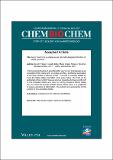Files in this item
Acetyl coenzyme A analogues as rationally designed inhibitors of citrate synthase
Item metadata
| dc.contributor.author | Bello, Davide | |
| dc.contributor.author | Rubanu, Maria Grazia | |
| dc.contributor.author | Bandaranayaka, Nouchali | |
| dc.contributor.author | Götze, Jan. P. | |
| dc.contributor.author | Bühl, Michael | |
| dc.contributor.author | O'Hagan, David | |
| dc.date.accessioned | 2020-03-29T00:32:00Z | |
| dc.date.available | 2020-03-29T00:32:00Z | |
| dc.date.issued | 2019-05-02 | |
| dc.identifier | 257337674 | |
| dc.identifier | 5e244294-a820-4889-9a15-0fdf758c8b60 | |
| dc.identifier | 85063648758 | |
| dc.identifier | 000471317500013 | |
| dc.identifier.citation | Bello , D , Rubanu , M G , Bandaranayaka , N , Götze , J P , Bühl , M & O'Hagan , D 2019 , ' Acetyl coenzyme A analogues as rationally designed inhibitors of citrate synthase ' , ChemBioChem , vol. 20 , no. 9 , pp. 1174-1182 . https://doi.org/10.1002/cbic.201800700 | en |
| dc.identifier.issn | 1439-4227 | |
| dc.identifier.other | RIS: urn:F49DA2F0A70BE27DA6A2078040DD5C18 | |
| dc.identifier.other | ORCID: /0000-0002-1095-7143/work/56184269 | |
| dc.identifier.other | ORCID: /0000-0002-0510-5552/work/68281230 | |
| dc.identifier.uri | https://hdl.handle.net/10023/19724 | |
| dc.description | Authors thank the EPSRC (Grant EP/N03001X/1) for financial support. | en |
| dc.description.abstract | In this study, we probed the inhibition of pig heart citrate synthase (E.C. 4.1.3.7) by synthesising seven analogues either designed to mimic the proposed enolate intermediate in this enzyme reaction or developed from historical inhibitors. The most potent inhibitor was fluorovinyl thioether 9 (Ki=4.3 μm), in which a fluorine replaces the oxygen atom of the enolate. A comparison of the potency of 9 with that of its non‐fluorinated vinyl thioether analogue 10 (Ki=68.3 μm) revealed a clear “fluorine effect” favouring 9 by an order of magnitude. The dethia analogues of 9 and 10 proved to be poor inhibitors. A methyl sulfoxide analogue was a moderate inhibitor (Ki=11.1 μm), thus suggesting hydrogen bonding interactions in the enolate site. Finally, E and Z propenoate thioether isomers were explored as conformationally constrained carboxylates, but these were not inhibitors. All compounds were prepared by the synthesis of the appropriate pantetheinyl diol and then assembly of the coenzyme A structure according to a three‐enzyme biotransformation protocol. A quantum mechanical study, modelling both inhibitors 9 and 10 into the active site indicated short CF ⋅⋅⋅ H contacts of ≈2.0 Å, consistent with fluorine making two stabilising hydrogen bonds, and mimicking an enolate rather than an enol intermediate. Computation also indicated that binding of 9 to citrate synthase increases the basicity of a key aspartic acid carboxylate, which becomes protonated. | |
| dc.format.extent | 2238756 | |
| dc.language.iso | eng | |
| dc.relation.ispartof | ChemBioChem | en |
| dc.subject | Citrate synthase | en |
| dc.subject | Mechanism | en |
| dc.subject | Enzyme inhibition | en |
| dc.subject | Organo-fluorine chemistry | en |
| dc.subject | Coenzyme A analogues | en |
| dc.subject | QD Chemistry | en |
| dc.subject | NDAS | en |
| dc.subject.lcc | QD | en |
| dc.title | Acetyl coenzyme A analogues as rationally designed inhibitors of citrate synthase | en |
| dc.type | Journal article | en |
| dc.contributor.sponsor | EPSRC | en |
| dc.contributor.institution | University of St Andrews. School of Chemistry | en |
| dc.contributor.institution | University of St Andrews. EaSTCHEM | en |
| dc.contributor.institution | University of St Andrews. Biomedical Sciences Research Complex | en |
| dc.identifier.doi | https://doi.org/10.1002/cbic.201800700 | |
| dc.description.status | Peer reviewed | en |
| dc.date.embargoedUntil | 2020-03-29 | |
| dc.identifier.grantnumber | EP/N03001X/1 | en |
This item appears in the following Collection(s)
Items in the St Andrews Research Repository are protected by copyright, with all rights reserved, unless otherwise indicated.

